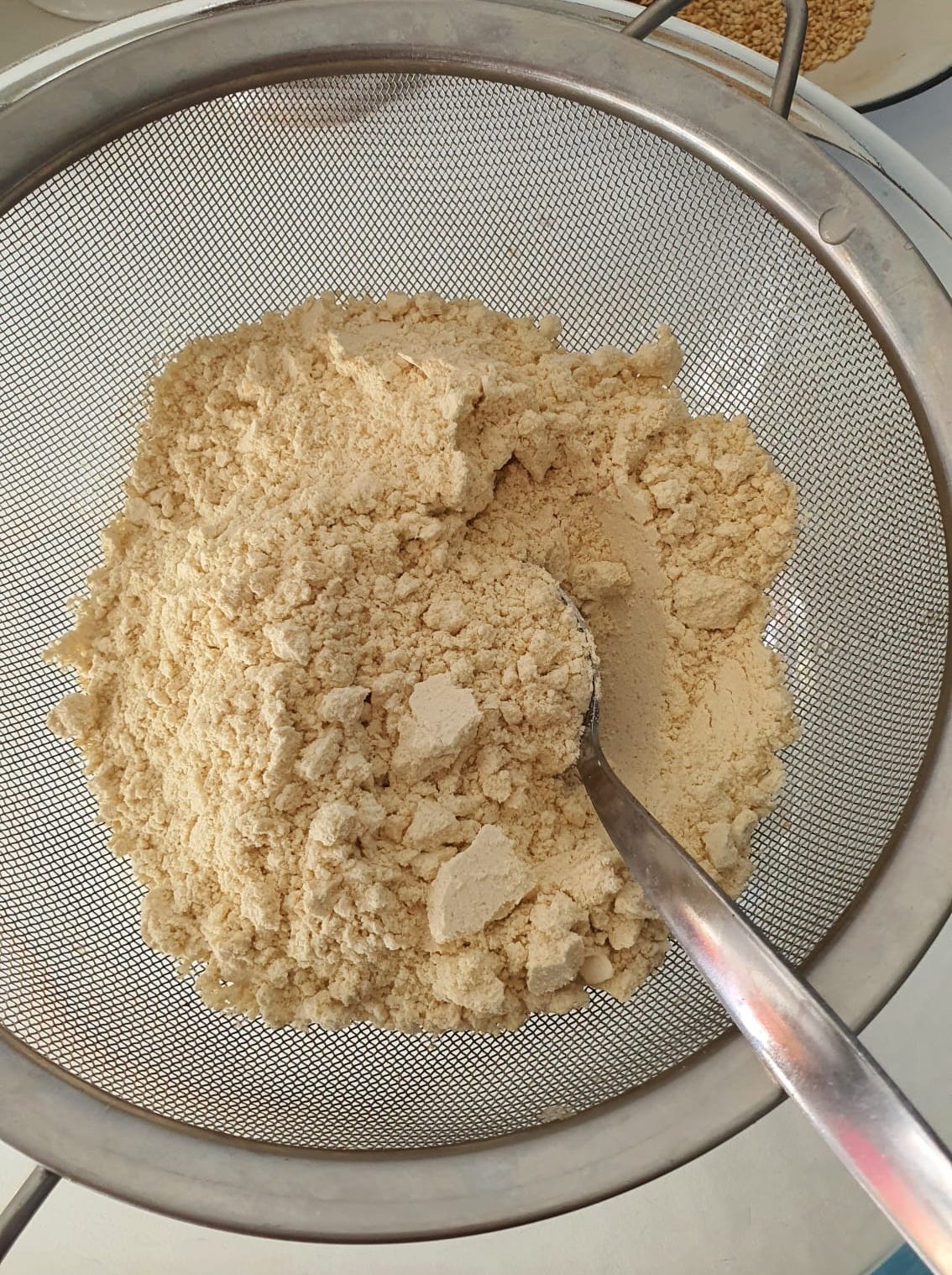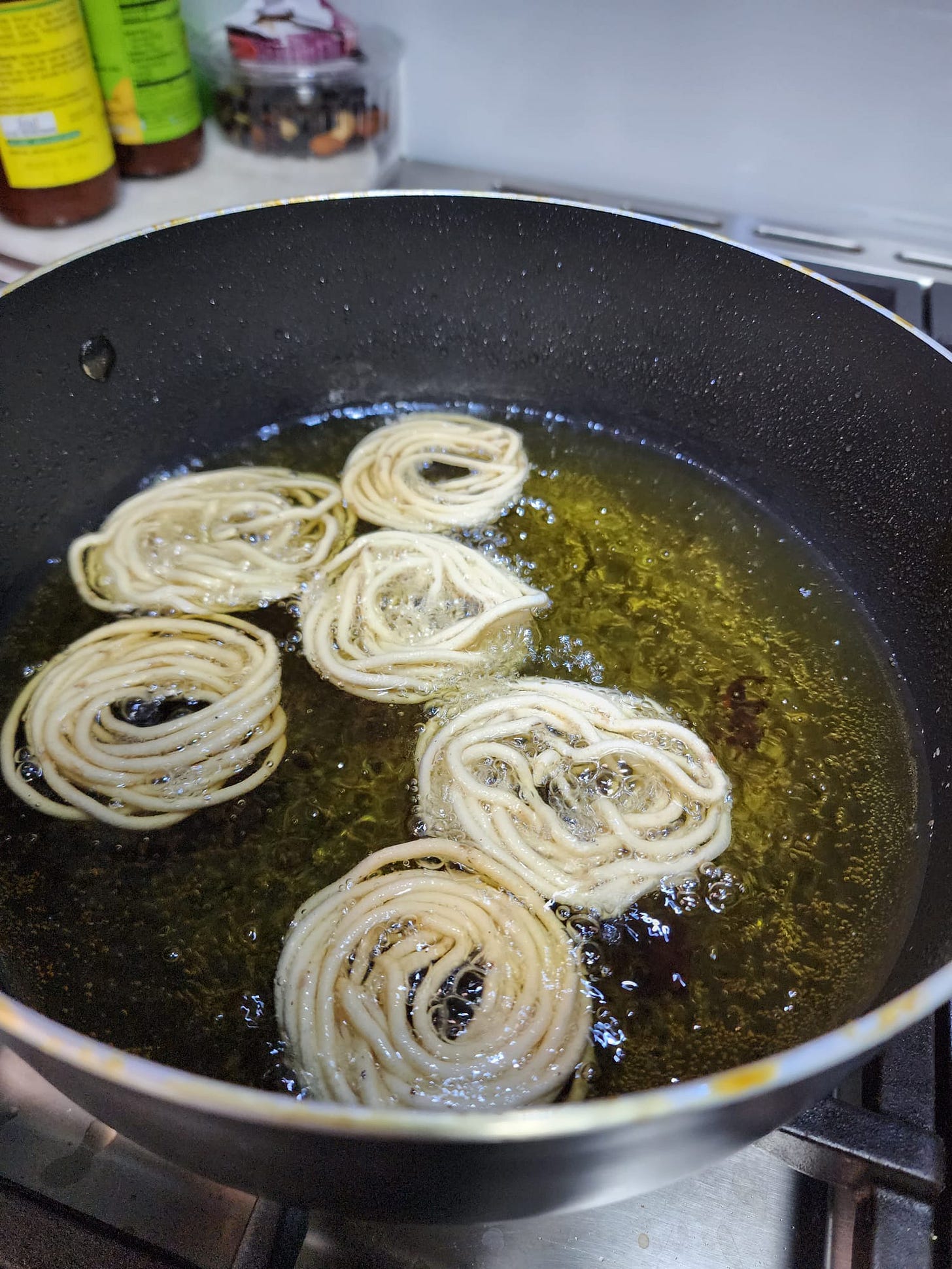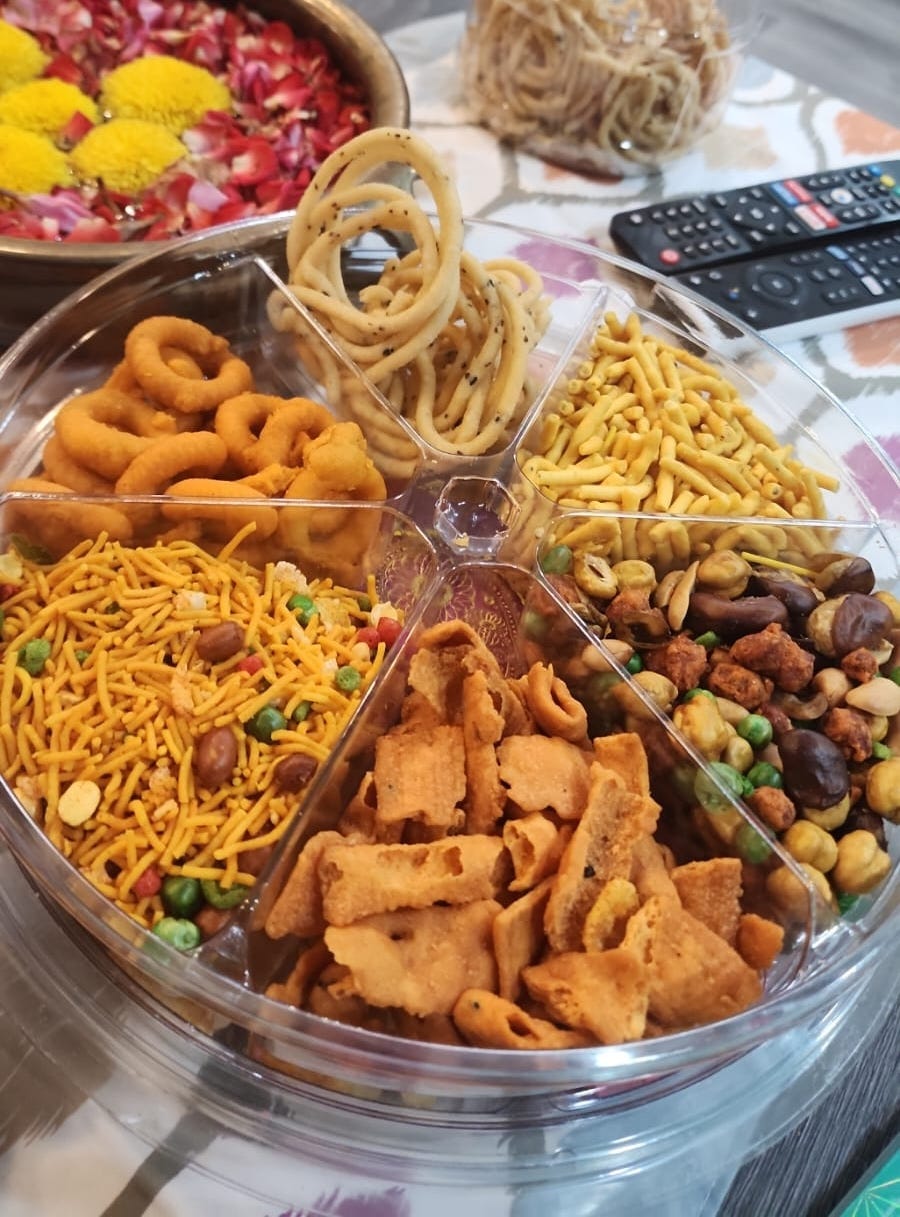✨ Welcome to Singapore Noodles, a newsletter dedicated to celebrating Asian culinary traditions and food cultures. Archived recipes and other content can be found on the index. My book Plantasia: A Vegetarian Journey Through Asia is available from my website or from international stockists such as Kitchen Arts and Letters (US), Donner Bookstore (NL), Readings (AU), and Goldhanh und Sampson (DE).
As Deepavali is coming up in approximately two weeks, I’ve invited Aruna Shanmuga Vadivel to share about thenkuzhal murukku. We got to know each other over Instagram when we were both living as Singaporeans in Australia a few years ago. Now, Aruna has moved back to Singapore and I’m based in the Netherlands. When I was in Singapore recently, Aruna invited me over for a lesson on murukku-making. Even though she is only 32 years old, she is seasoned in the kitchen and it shows. I never liked murukku growing up, finding the commercial versions too overly spiced or salty. They also often leave me feeling thirsty, but Aruna’s murukkus, I can eat a mountain of. They are that dangerous. In the transcribing of her recipe, Aruna gave me approximate measurements in teaspoons and cups and we got on video calls to work through the precise measurements and things to look out for as I cooked. In the Netherlands, I dropped a container of these off at an Mumbai friend’s house and gave another to Wex to take to work. My Indian friend messaged that saying that it tasted exactly like what he gets in India, and Wex came home with an empty box — all this is a testament to Aruna’s patient teaching and intuitive cooking ability.
Do you enjoy receiving Singapore Noodles in your inbox every week? For the price of one lunch, you can keep it going! Each paid subscription supports the research and recipe testing that goes into each newsletter, pays guest-writers, and gives you access to all content and recipes. Thank you for being here and enjoy this week’s post. ✨
Thenkuzhal Murukku
By Aruna Shanmuga Vadivel
To me, as it is to many other Indians, murukku is the best snack. A savoury snack made by kneading together a spiced lentil and rice dough and extruding it into hot oil as individual “cookies”, it is incredibly moreish. Murukku is essential to Deepavali celebrations as it is the very first thing that we offer guests when they step through the door. In my household, the making of murukku typically begins 10 days before Deepavali and requires the coming together of the entire family. This might sound extreme, but this is because we make so much murukku each year, in anticipation of the many people whom we will host over the festive season in our respective homes. Solely in my late Aatha (maternal grandmother)’s home, there could be 50 guests each year.
Aatha used to make seven types of murukku from scratch for Deepavali and our prayer rituals at home. I have only learnt to make two — ribbon murukku and thenkuzhal murukku — as these were the easiest of the seven to master. While ribbon murukku is less common, thenkuzhal murukku is a Deepavali staple that most Indian families would prepare or purchase each year.
The recipe that I use is from Aatha, but murukku-making is a very intuitive process. It requires you to develop a feel for the dough and be observant and discerning throughout the cooking. My grandmother and mother never used precise measurements to make murukku, and I’m the same; we measure everything with cups that we have at home, and use the same cup to gauge ratios, similar to the way the French make cakes by measuring ingredients with yogurt containers. We have also never tested the temperature of oil with a thermometer. Aatha’s technique is to fry a pappadum to check: does it float up immediately? Is it browning or does the pappadum stay a uniform pale gold? To know when murukku is ready, our family’s method is to listen attentively to the sound of the bubbles. There’s less gadgetry and more reliance on our senses.
The flour component of thenkuzhal murukku is made up of three ingredients: urad dal, pottukadalai, and rice. Years ago, Singaporean cooks would buy these, roast the grains, and bring them to the old mill along Serangoon Road to be turned to flour. Today, most people rely on store-bought flours or murukku mixes for convenience, but I always toast and grind my own urad dal and pottukadalai.
Rice flour is a finely milled flour that is typically used in kueh-making and other desserts; it provides the dough with structure and is what accounts for the crispness of the murukku. Even when using store-bought rice flour, the freshness of the flour is imperative, as stale rice flour produces murukku with less crunch.
Urad dal, also known as black gram, is sold split or whole in stores — both can be used in this recipe. When toasted, urad dal produces a wonderful fragrance that mingles with the spices.
Pottukadalai is chana dal (split chickpeas) that have been roasted; this ingredient makes the murukku extra crisp.
Rice flour is available at almost any Asian grocer, while urad dal and pottukadalai is usually exclusive to Indian grocers. Once toasted, the urad dal and pottukadalai are ground to form a fine flour that’s incredibly fragrant, before being mixed with the rice flour.
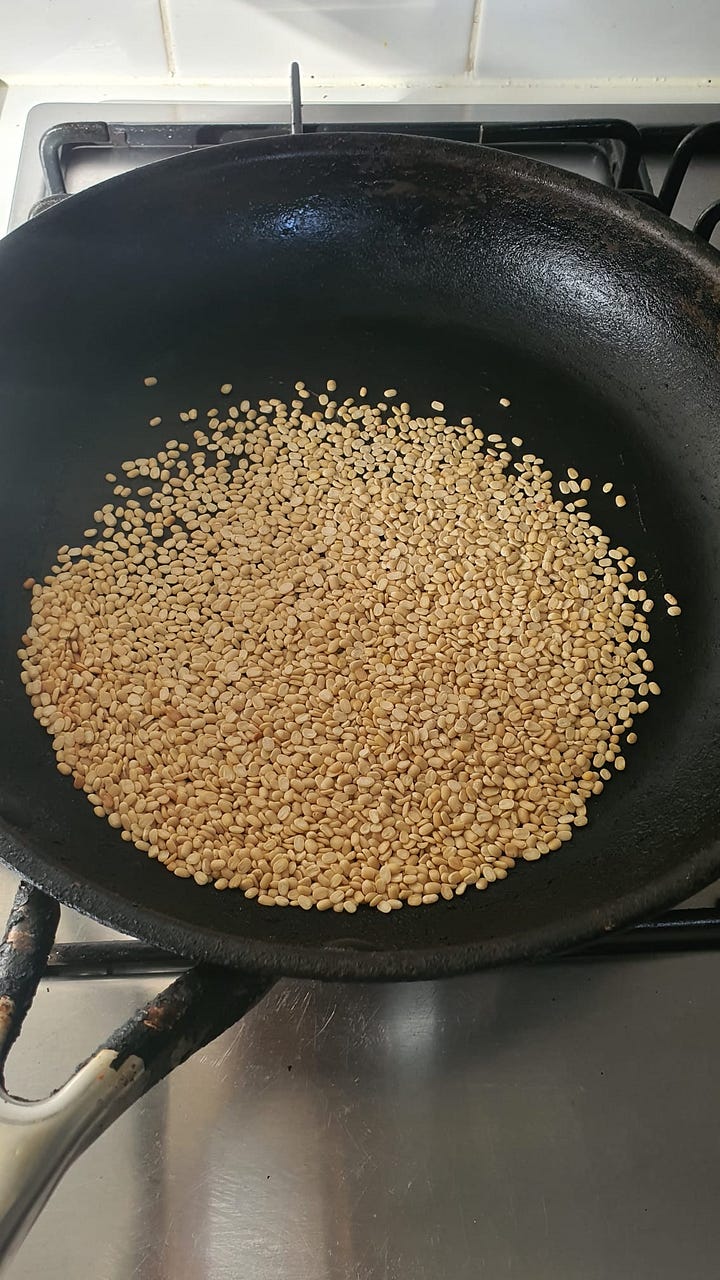
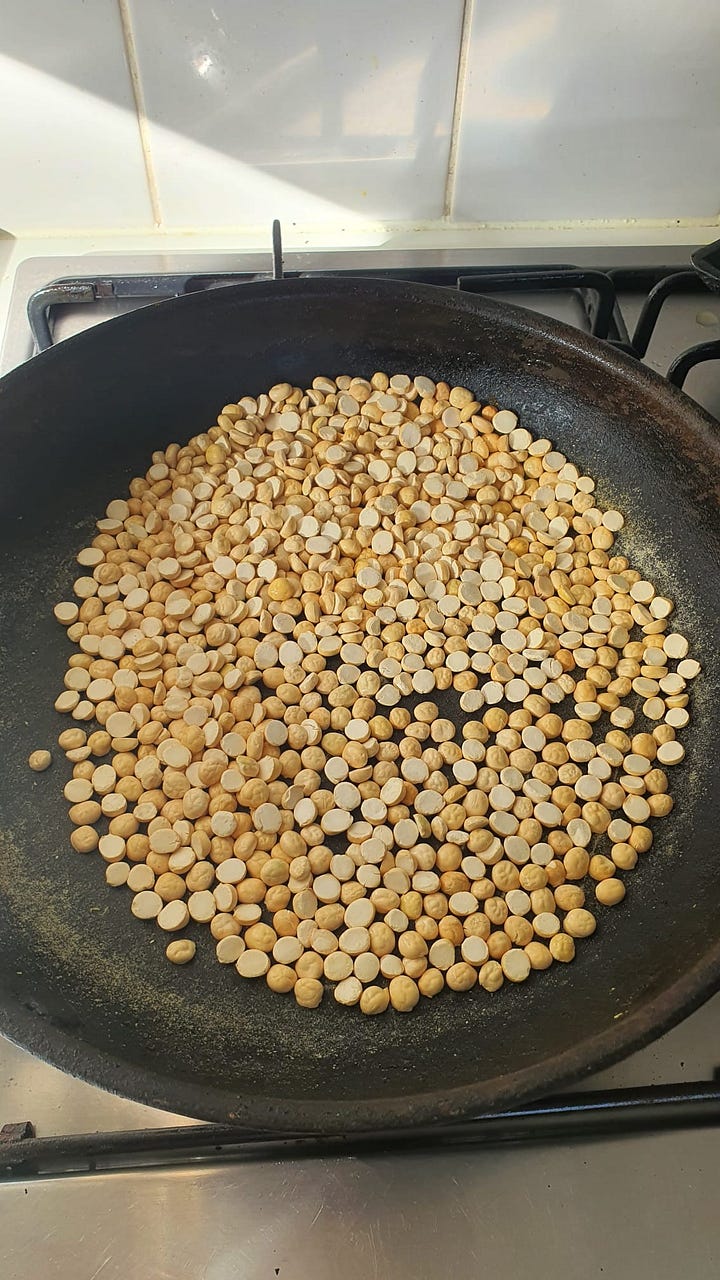
To the flavour the dough, we have:
Toasted sesame seeds
Toasted cumin seeds: Cumin has a nice scent and aids in digestion, but sometimes the seeds can get clogged in the murukku press. To get around this, we grind the seeds with a mortar and pestle just until they turn into a coarse powder, before incorporating them with the rest of the ingredients.
Toasted and ground ajwain (carom): Ajwain is a very powerful spice — if used in abundance, it could turn the murukku bitter. Only a pinch or two, toasted and ground with a pestle and mortar, is sufficient. Murukku should be subtle but addictive, not overly spiced!
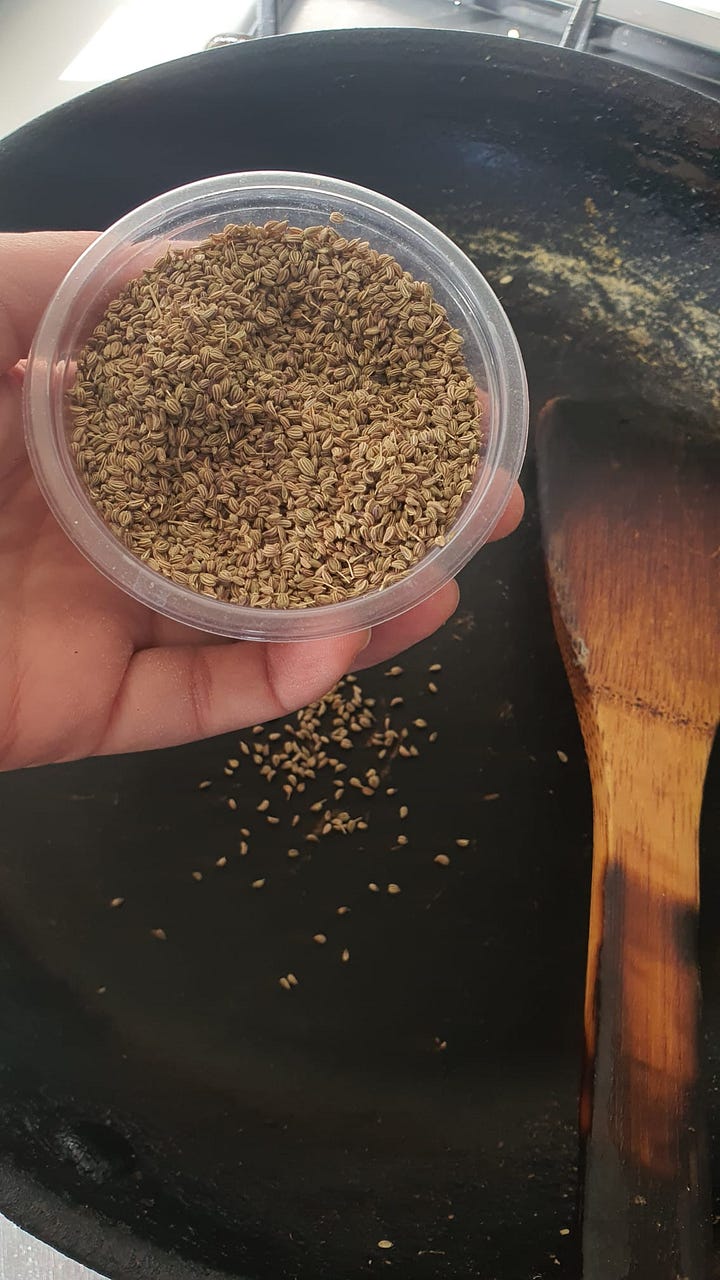

Murukku dough also has a small amount of fat in it in the form of:
Soft butter: Sometimes murukku can be crunchy to the point of being difficult to break; butter keeps the murukkus from being too hard.
A splash of hot oil: I don’t always add this, but this can help prevent the dough from cracking, particularly in cold climates.
Water is added and everything is kneaded to form a very soft but non-sticky dough.


Thenkuzhal murukku is typically made with a murukku press fitted with a perforated plate. My mother and Aatha extrude the dough directly into hot oil, but I always extrude the individual cookies onto brown paper first because I have had accidents trying to churn the dough over hot oil.

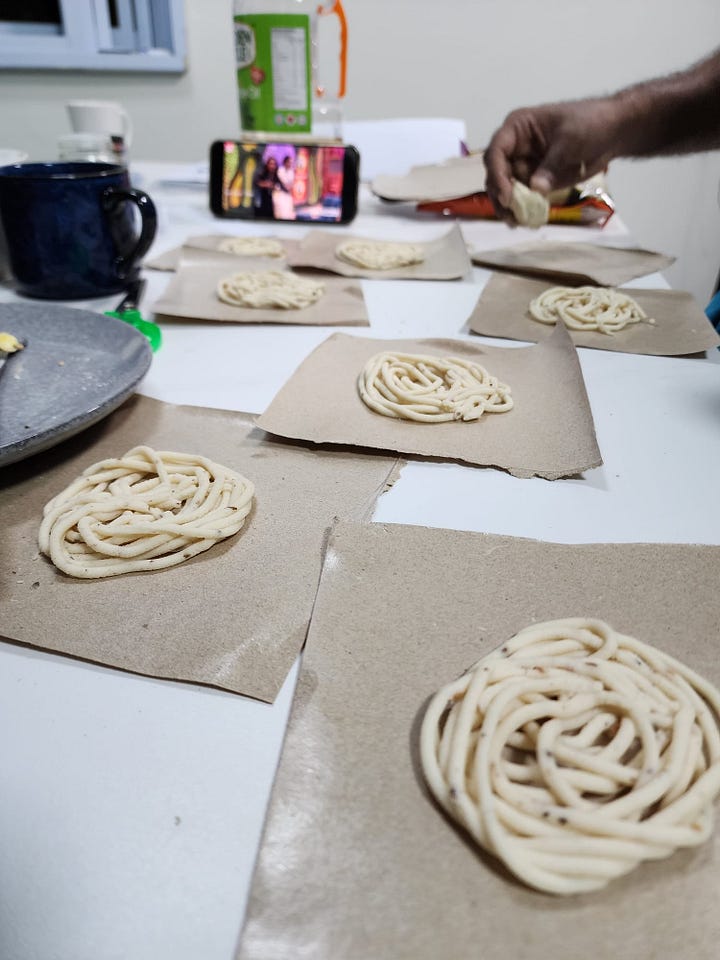
In the absence of a murukku press or such a plate, you can still make murukku! One option is to use a murukku press with a different plate. For example, a plate with three holes can form a similar shape, but with fewer, thicker strands. Otherwise a star plate can be used to extrude a long strand of dough and coiled up to form a spiral pattern. When I was living in Arizona, I even used a piping bag even though it did require a lot of arm strength. You can even roll the dough 2mm-thick and cut it into diamonds with a knife — no murukku press needed! The beauty of murukku is that it shouldn’t need to be in one size or shape. Whichever method you use, fry the murukku gently and be patient. They should be crunchy all the way through and turn a light pale golden when they are ready.




Because we make so many murukku at a time, we would have a conveyor belt-like production line to fry the murukku. Aatha would be the one ensuring that the consistency of the dough is right. The dough gets passed on to my aunt, who provides the muscle in this operation. My mother and I would be the ones frying the murukku and setting them in baskets lined with newspapers to absorb excess grease. Finally, my father and sister would be at the end of the assembly line layering the murukku into glass bottles. These would be sealed with tape to keep them as fresh as possible, but to also keep all of us from sneaking a bite before Deepavali. Sealed properly, homemade murukku stays fresh with no preservatives for months. When Deepavali eventually comes and the containers of murukku are opened, it’s a joyous occasion, almost like opening up presents on Christmas day.
One last piece of advice: in this season, prepare and drink cumin, fenugreek, and fennel water to aid digestion. Just throw 1 teaspoon each into 2 cups of water in a pot and boil for 15 minutes. Drink it hot or warm — this helps to prevent bloating from eating too many murukku!
🌷Singapore Noodles Chat: If you’re a long-time subscriber, you might be aware that Singapore Noodles used to have a Discord channel — a conversation space where people can knowledge-share and ask questions. Now that Substack has this feature, I’ve reignited this part of the Singapore Noodles universe. You can join in via the Substack app: Open the app and tap the Chat icon. It looks like two bubbles in the bottom bar, and you’ll see a row for my chat inside. Alternatively, you can access the chat on the web. If you’re attempting this recipe and would like to clarify anything or share your results, feel free to do so via the Chat! We currently have a Deepavali-themed thread going — would love to see what you all are cooking and enjoying this festive season!
Thenkuzhal Murukku
Makes 32 murukku





